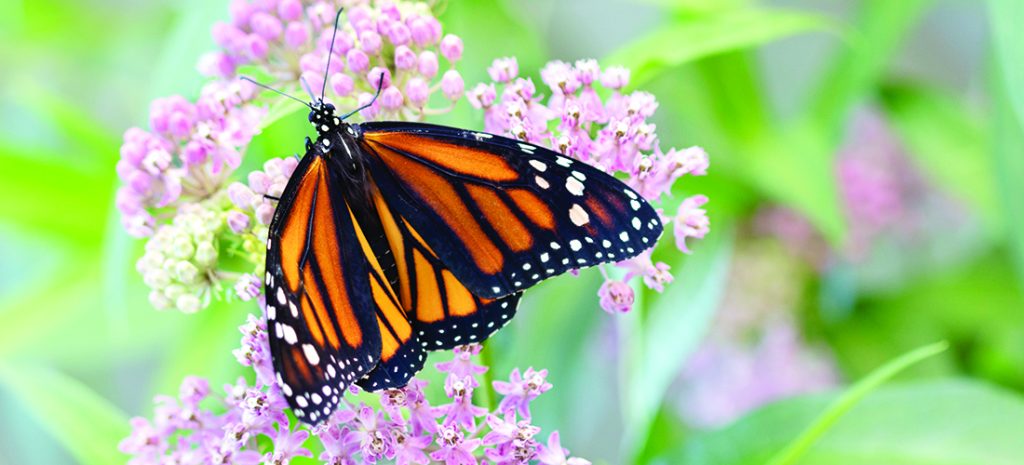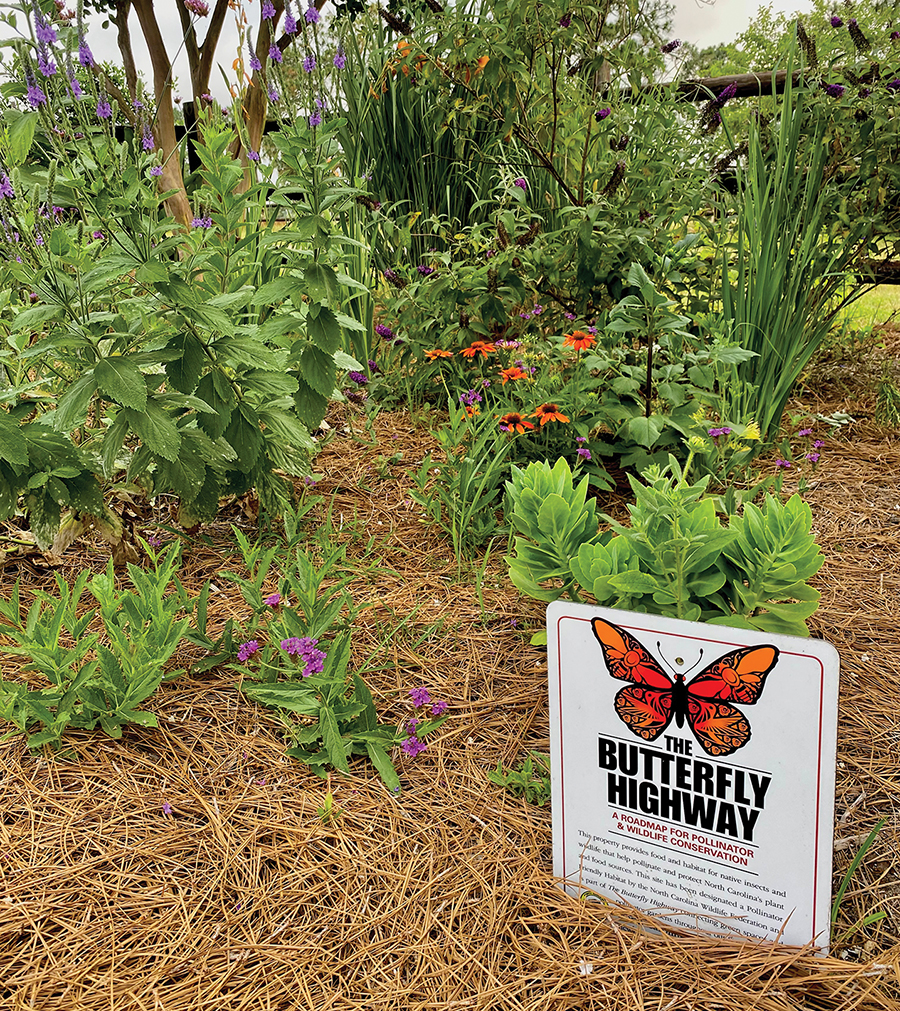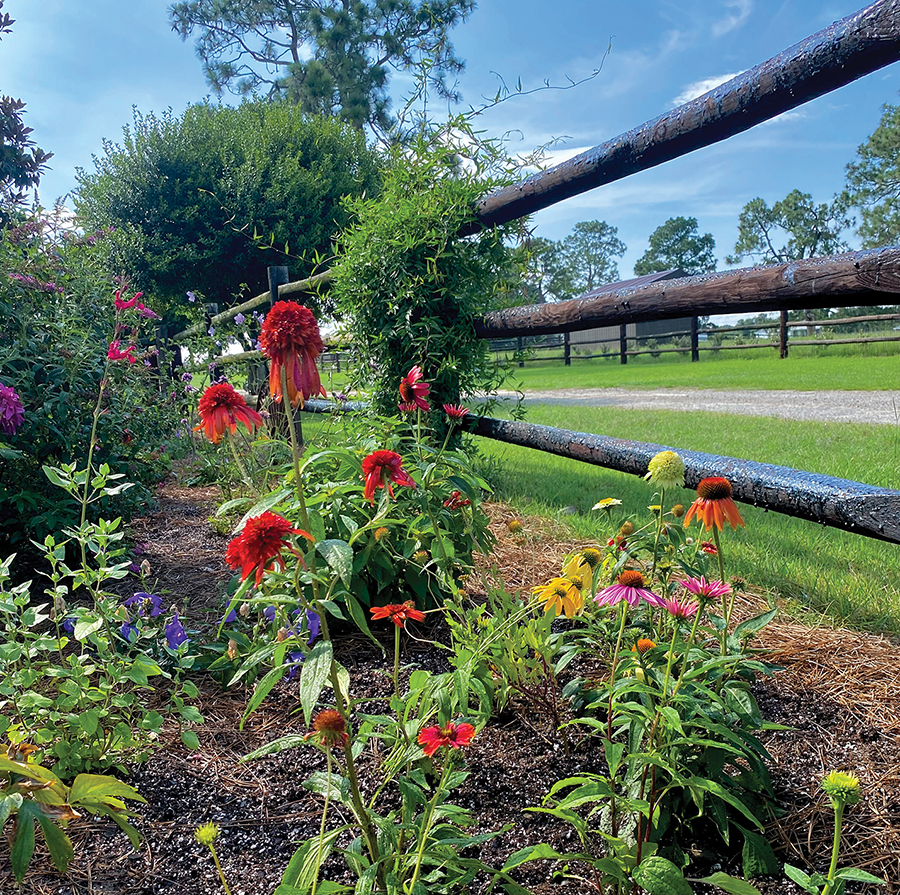Butterfly Highway

A neighborhood creates a pollinator pitstop
By Jan Leitschuh

 Left: Dez MacSorley
Left: Dez MacSorley
If you have lived five or six or seven decades, you remember the abundant orange and black monarch butterflies of your childhood. Hardly a summer day would pass without seeing one, if not scores of them.
Today, if you see one, it’s Facebook- or Instagram-worthy because of the butterfly’s rarity. There are a number of reasons the population has crashed in the last couple decades, but crash it has.
One neighborhood in Southern Pines is fighting back. A dedicated group of neighbors is working to transform their long street into a connected and welcoming pollinator paradise, not just for monarchs but all declining butterflies, birds and native insects.
This month, the fall monarch migration begins winging its perilous journey to Mexico, laying eggs on milkweed, exclusively, along the way. An extensive stretch of Sheldon Road will be waiting with open arms with milkweed for eggs and nectar plants for sustenance — all pollinators welcome.
“Pollinators continue to make global headlines as native bees and migrating species such as monarch butterflies decline,” writes the North Carolina Wildlife Federation. “Habitat loss from development is the primary cause of population decline, followed by pesticide and fungicide use, as well as parasites and diseases.”
In response, the federation developed the concept of a North Carolina “Butterfly Highway,” a statewide conservation initiative aimed at restoring pollinator habitat, from citizen-driven, backyard “Pollinator Pitstops” to large-scale habitat rejuvenation of roadsides, agricultural margins and development.
Individuals answered the call. Homeowners and garden clubs began taking up the torch to raise awareness and create inviting habitat for these vulnerable and iconic lovelies. Some farms planted long strips of pollinator plants.
Threatened monarchs are at the forefront of the public awareness, as these butterflies only lay their eggs on milkweed species. As milkweed declined due to abundant agricultural use of glysophate weed killers versus mowing (which allows the plant to regenerate from the roots) and general habitat loss, so did the monarchs. Fifteen years ago, I read about the precipitous drop in the monarch populations. Conservation organizations were sounding the alarm and pleading with anyone who would listen to plant milkweed.
A visit to a remote Virginia meadow that fall yielded several ripe pods of the common milkweed variety. I tucked the seeds in my cottage garden here and forgot them. Next spring, I had milkweed, and have ever since. Thus began my butterfly journey, near the southern end of Sheldon Road.
About the same time, interest in native plants and pollinator-friendly gardens ripened into the public awareness too. Nearly a mile away from me, on a horse farm at the far northern, sand-road end of Sheldon, retired landscape architect and beekeeper Dez MacSorley designed her farm and decided to have a pesticide-free, non-manicured, tufted grass lawn. “Aside from the horse pastures, I turned all the other bits of land into a continuous meadow devoted to pollinator-friendly perennials and native grasses,” she says. This is the third year for the meadow and its beneficiaries.
“Come they have, “ MacSorley says. “Butterflies, bees, wasps, birds, moths — all come to feed on, find shelter in and enjoy my little meadow.”
She says her nearby Sheldon neighbors inspired her from the beginning, including avid gardeners Lynn McGugan, Cameron Sadler, Tayloe Moye and Carol Phillips, who has since passed away, all with different, complementary styles, and a passion for supporting and extending the natural environment.


In April 2021, Molly Thompson-Hopton, Cameron and Lincoln Sadler’s niece, started a Facebook garden group for her plant-loving friends, and the photo-sharing, education and awareness caught fire. “I guess you could say a love of wildlife and plants runs in our family,” she says.
“We started trading plants and knowledge,” MacSorley says. One of her neighbors, Sara Hoover, started a milkweed patch on her property adjacent to the Walthour Moss Foundation.
Thompson-Hopton, though living 8 miles away, caught the conservation bug. “After I moved to the family farm in Aberdeen, I got busy planting,” she said. “I knew I wanted to attract pollinators. I stumbled across some clasping milkweed and brought it home. I have four varieties of milkweed now and hope to add more.”
Through the plant trading on Thompson-Hopton’s social media page, I shared some milkweed plants with Lynn McGugan several years ago. She tucked them in near her other pollinator plants. McGugan, a force of nature, does nothing by half-measures. Before long, armed with information, she was out preaching the benefits of milkweed, pollinators and native plantings.
“Pollinator plantings add beauty to any landscape,” says McGugan, “and serve a purpose.”
A skilled photographer, McGugan posted gorgeous, envy-creating photos of various butterflies, caterpillars, moths and native bees feasting on her nectar banquet. Then McGugan and MacSorely hatched a plan to share the plant love even further.
“We intend to extend our pollinator-friendly native plantings down the natural edges of Sheldon Road,” says MacSorley, “creating a natural environmental corridor between all our properties, the Walthour Moss Foundation land and, who knows, maybe including some of the new houses further up Sheldon and along Youngs Road. This is truly the ‘butterfly effect’ at work.”
As tall pines came down and new houses went up this summer on Sheldon and just off it, McGugan walked up to a job site and grabbed a number off the sign, then started a conversation with Chris Styne of Homes by Dickerson. She found a willing ear in Styne. In a recent email he wrote: “Homes by Dickerson is excited to . . . be a part of such a unique and necessary organization such as this. We are committed to planting flowers at each of our eight new homes being built on Braden and Sheldon Road.”
Encouraged, McGugan has reached out to other builders. She engaged Seth Mabus of Mabus Farm & General Contracting and came away with a commitment for all new builds to include pollinator gardens. “They have the potential for such impact by just including a few beneficial shrubs and trees,” she said. “It all adds up.”
Across the road, farm owner Tricia Greenleaf and John Robertson started their own patch of milkweed this year, right next to a massive, nectar-rich Miss Huff lantana. McGugan offered them rooted cuttings in pots from some of her own flowering shrubs.
McGugan’s near neighbors in horse country, Sadler and Moye, have cultivated stunning gardens too, sisters inheriting their mother Carol’s love of plants.
“Initially,” says Moye, “I bought a milkweed plant because I was interested in having butterflies. It got covered with caterpillars and they were eating the leaves so I used a pesticide and killed all of them. When I told Lincoln what happened, he said, ‘You just killed all the butterflies.’ That was 14 or 15 years ago.” Moye was heartsick, but soon made up for her pesticide error.
“I have been gardening since a child, continuously throughout my life,” she says, “and I believe it saved me in the worst of times. I have become more interested in native plants over the last 10 years. I’m pretty sure Lynn McGugan was my initial inspiration. I saw what she was doing and over the last three years ordered every type of milkweed I could find on the internet along with other native plants.”
On a long stretch of Sheldon Road, from Foundation-adjacent horse farms to suburban new construction and out the other end to Weymouth Woods, a butterfly-friendly corridor is shaping up, thanks to enthusiastic neighbors.
“Nature fills me with joy and I feel like I’m contributing to the greater good by being an active participant,” says Moye.
Sometimes, it takes a village. PS
Jan Leitschuh is a local gardener, equestrian, avid eater of fresh produce and co-founder of Sandhills Farm to Table.
GREAT PLANTS FOR CATERPILLARS
Butterflies get all the love, and they sip energy-rich nectar from many pollinator-friendly plants. But no caterpillars, no butterflies. Often, when their host plants decline, so does the species. Witness monarchs, who only lay their eggs on milkweed.
As habitat is destroyed, we can help by including a few friendlies for North Carolina butterflies to lay their eggs on, such as:
For monarchs: the milkweed family — common, tuberosa, swamp, clasping and more — offers exclusive food for the monarch caterpillars. These plants tolerate poor soil and never need fertilizing. All milkweeds contain cardiac glycosides in their sap that monarchs consume and store in their bodies. Potential predators learn to steer clear of this bitter, stored substance.
For swallowtail: Dill, fennel, parsley, common rue, carrot greens, tulip tree, wild black cherry.
For fritillaries: passion vine, maypops, violets.
For American painted lady: thistles, mallows, yellow fiddleneck.
For common buckeye: aster, peppermint, tickseed sunflower, chicory.
